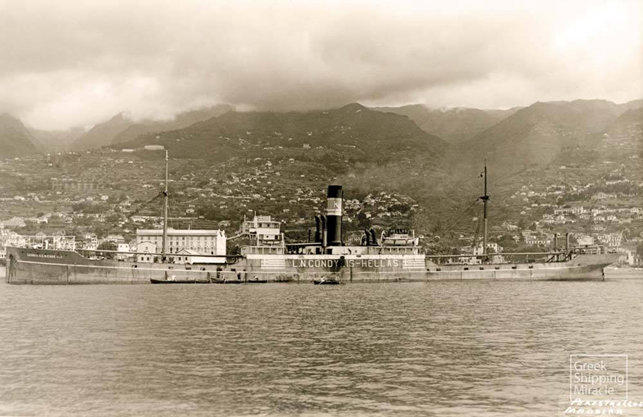
copyright © Wartime Heritage Association
Website hosting courtesy of Register.com - a web.com company
Wartime Heritage
ASSOCIATION
Remembering World War II
Name:
Charilaos Inglessis
Rank:
Engineer
Service:
SS Leonidas N. Condylis, Greek Merchant Navy
Date of Birth:
August 10, 1898
Place of Birth:
Athens, Greece
Residence:
Stepney, East London, England
Date of Death:
February 9, 1945
Age:
46
Cemetery:
Mountain Cemetery, Yarmouth, Nova Scotia
Grave:
Reserve Lot 120 (unmarked grave)
Charilaos Inglessis was from Athens, Greece, the son of Georgios and Pandora Inglessis of Athens, Greece. During
WWII, his residence when not at sea was in Whitechapel in the Stepney borough of East London, England
He served on the merchant vessel SS Leonidas N. Condylis during the Second World War.
Charilaos Inglessis became seriously ill in late January of 1945 and was admitted to the Yarmouth hospital on
February 2nd and was attended by Dr. Burton until his death on February 9th. Charilaos died of pulmonary
tuberculosis. An engineer from the Leonidas N. Condylis signed the death certificate. It was recorded that
Charilaos had been in the province for two weeks and in Yarmouth for seven days.
He was buried on February 13, 1945, in Reserve Lot 120 at Mountain Cemetery in Yarmouth, NS.
After Greece fell to Axis forces in 1941, the Greek government relocated to Cairo and later London. From there,
it continued to oversee the merchant fleet, which was one of the largest in Europe at the time. The Greek
Ministry of Merchant Marine remained active and coordinated with Allied authorities to manage Greek-flagged
vessels. Many ships were chartered to the British Ministry of War Transport.
The later-named SS Leonidas N. Condylis was built in 1912 by built by Messrs. Wm Gray and Co. for Rickinson
Sons & Co., of West Hartlepool, County Durham, England, and named the SS Arachne. The ship went by other
names including the SS Swiftway (1922), the SS Aurora (1932), and the SS Bransome Chine, renamed in 1934,
when purchased by the Chine Shipping Co. It was purchased by D.L. Condylis of Andros, Greece, and renamed
the SS Leonidas N. Condylis in 1935.
The SS Leonidas N. Condylis travelled in the following 4 Convoys during the Second World War:
Convoy SL 78 sailed from Freetown, Sierra Leone to Liverpool between June 18 and July 12, 1941. Comprising
26 merchant ships and 19 escorts, it faced significant U-boat attacks en route, with eight ships lost to
submarines including U-69, U-123, and U-66. The convoy’s experience underscored the vulnerability of long-
haul routes from Africa during the early war years, when escort coverage in the South Atlantic and mid-ocean
gaps was still limited and U-boat tactics were proving highly effective.
Convoy ON 144 departed Liverpool in early November 1942 and was attacked in the North Atlantic by the
German wolfpack Kreuzotter. The convoy suffered the loss of 5 merchant ships and 1 escort corvette, while one
U-boat was destroyed in the engagement. Despite these losses, the majority of the convoy reached its
destination, though the encounter was considered a tactical victory for the Germans and highlighted the
ongoing danger of mid-ocean crossings before full air coverage was established.
Convoy ON-53 was part of the outbound transatlantic series that sailed from Liverpool to North America during
World War II. Departing on January 5, 1943, it represented the increasingly secure passage across the Atlantic as
Allied escort tactics and air coverage improved. Although ON convoys were often targeted by German U-boats,
ON-53 completed its journey without major incident, reflecting the growing effectiveness of mid-ocean escort
groups and technological advances like radar and HF/DF.
Convoy SC 133 sailed from Sydney, Nova Scotia to Liverpool in the spring of 1943, a pivotal period in the Battle
of the Atlantic. As a slow convoy, it was more vulnerable to U-boat attacks, but SC 133 benefited from the Allies’
enhanced escort coordination and air patrols. These improvements helped ensure its safe arrival, marking a
shift in momentum as the Allies began to gain the upper hand against the German submarine threat.
On July 24, 1944, The SS Leonidas N. Condylis struck an iceberg in thick fog near Cape Bauld, Newfoundland,
severely damaging the bow. There were no injuries to the crew.
Charilaos Inglessis


Sources:
NS Death Certificate
Burial Plot – Yarmouth Mountain Cemetery
Ship-Iceberg Collision Incident Report




- World War I - Menu
- WWI Stories and Articles
- Photos - Yarmouth Soldiers
- Selection of World War I Songs
- WWI Casualties of Yarmouth, NS
- Those Who Served - Yarmouth, NS
- WWI Casualties Digby Co. NS
- WWI Casualties Shelburne Co. NS
- Merchant Mariners (1915) Yarmouth, NS
- Canadian Forestry Corps - Non Yarmouth Birth/Residence Enlistments
- US Draft Registry - Yarmouth NS Born


- World War II - Menu
- WWII Stories and Articles
- Telegraphist Air Gunners
- WWII Casualties of Nova Scotia
- US Casualties with NS Connection
- Far East/Pacific Casualties with NS Connection
- Merchant Navy Casualties Nova Scotia
- Nova Scotia WWII Casualties Holten Canadian War Cemetery
- D-Day Casualties - Nova Scotia
- CANLOAN Program Casualties - Nova Scotia
- Battle of the Bulge Casualties - Nova Scotia
- WWII Casualties Yarmouth NS
- Yarmouth Casualties - RCAF RAF Canadian Army WWII
- Yarmouth Co., Marriages WWII
- Casualties Non-Born/Residents with Connection to Yarmouth Co., Nova Scotia.
- WWII Casualties Digby Co., NS
- Non-Nova Scotian WWII Casualties Buried in Nova Scotia
- WWII RCAF Casualties Aged 16-18
- Brothers/Sisters Who Served - World War II













